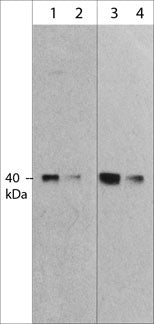Anti-MuRF1 (C-terminal region) Antibody
- SPECIFICATION
- CITATIONS
- PROTOCOLS
- BACKGROUND

| Primary Accession | Q969Q1 |
|---|---|
| Reactivity | Bovine |
| Host | Mouse |
| Clonality | Mouse Monoclonal |
| Isotype | IgG1 |
| Clone Names | M316 |
| Calculated MW | 40248 Da |
| Gene ID | 84676 |
|---|---|
| Other Names | Tripartite motif 63, TRIM63, SMRZ, IRF, RNF28, Muscle RING finger, MURF-1 |
| Target/Specificity | Muscle proteolysis is regulated by the ATP-dependent ubiquitin–proteasome system. This system involves ubiquitination of specific proteins, leading to recognition and degradation by the 26S proteasome complex. Ubiquitination requires interactions with ubiquitin related proteins, ubiquitin-activating (E1), ubiquitin-conjugating (E2) and ubiquitin-ligating enzymes (E3) known as ligases. Two muscle specific ubiquitin ligases have been identified, muscle ring finger 1 (MuRF-1) and Atrogin 1. Both ligases are regulated by the Akt1/FOXO1 signaling pathway, and both proteins have been shown to be upregulated prior to the onset of atrophy in multiple models of muscle wasting, including disuse and cachexia. MuRF1 is also known as TRIM63, SMRZ, and RNF28, and its expression is upregulated after TNFα treatment in C2C12 cells and muscle tissue, while localization of MuRF1 protein has been observed in the cytoplasm and nucleus of cells. |
| Storage | Maintain refrigerated at 2-8°C for up to 6 months. For long term storage store at -20°C in small aliquots to prevent freeze-thaw cycles. |
| Precautions | Anti-MuRF1 (C-terminal region) Antibody is for research use only and not for use in diagnostic or therapeutic procedures. |
| Shipping | Blue Ice |

Thousands of laboratories across the world have published research that depended on the performance of antibodies from Abcepta to advance their research. Check out links to articles that cite our products in major peer-reviewed journals, organized by research category.
info@abcepta.com, and receive a free "I Love Antibodies" mug.
Provided below are standard protocols that you may find useful for product applications.
Background
Muscle proteolysis is regulated by the ATP-dependent ubiquitin–proteasome system. This system involves ubiquitination of specific proteins, leading to recognition and degradation by the 26S proteasome complex. Ubiquitination requires interactions with ubiquitin related proteins, ubiquitin-activating (E1), ubiquitin-conjugating (E2) and ubiquitin-ligating enzymes (E3) known as ligases. Two muscle specific ubiquitin ligases have been identified, muscle ring finger 1 (MuRF-1) and Atrogin 1. Both ligases are regulated by the Akt1/FOXO1 signaling pathway, and both proteins have been shown to be upregulated prior to the onset of atrophy in multiple models of muscle wasting, including disuse and cachexia. MuRF1 is also known as TRIM63, SMRZ, and RNF28, and its expression is upregulated after TNFα treatment in C2C12 cells and muscle tissue, while localization of MuRF1 protein has been observed in the cytoplasm and nucleus of cells.
If you have used an Abcepta product and would like to share how it has performed, please click on the "Submit Review" button and provide the requested information. Our staff will examine and post your review and contact you if needed.
If you have any additional inquiries please email technical services at tech@abcepta.com.













 Foundational characteristics of cancer include proliferation, angiogenesis, migration, evasion of apoptosis, and cellular immortality. Find key markers for these cellular processes and antibodies to detect them.
Foundational characteristics of cancer include proliferation, angiogenesis, migration, evasion of apoptosis, and cellular immortality. Find key markers for these cellular processes and antibodies to detect them. The SUMOplot™ Analysis Program predicts and scores sumoylation sites in your protein. SUMOylation is a post-translational modification involved in various cellular processes, such as nuclear-cytosolic transport, transcriptional regulation, apoptosis, protein stability, response to stress, and progression through the cell cycle.
The SUMOplot™ Analysis Program predicts and scores sumoylation sites in your protein. SUMOylation is a post-translational modification involved in various cellular processes, such as nuclear-cytosolic transport, transcriptional regulation, apoptosis, protein stability, response to stress, and progression through the cell cycle. The Autophagy Receptor Motif Plotter predicts and scores autophagy receptor binding sites in your protein. Identifying proteins connected to this pathway is critical to understanding the role of autophagy in physiological as well as pathological processes such as development, differentiation, neurodegenerative diseases, stress, infection, and cancer.
The Autophagy Receptor Motif Plotter predicts and scores autophagy receptor binding sites in your protein. Identifying proteins connected to this pathway is critical to understanding the role of autophagy in physiological as well as pathological processes such as development, differentiation, neurodegenerative diseases, stress, infection, and cancer.


